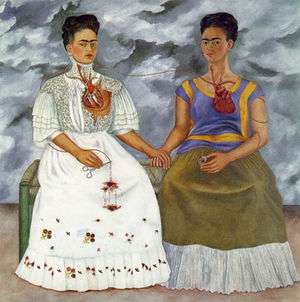The Two Fridas
The Two Fridas (Las dos Fridas in Spanish) is an oil painting by Mexican artist Frida Kahlo. The painting was the first large-scale work done by Kahlo and is considered one of her most notable paintings.[1] It is a double self-portrait, depicting two versions of Kahlo seated together. One is wearing a white European-style Victorian dress while the other is wearing a traditional Tehuana dress.[1] The painting is housed at the Museo de Arte Moderno in Mexico City.
| The Two Fridas | |
|---|---|
| Spanish: Las dos Fridas | |
 | |
| Artist | Frida Kahlo |
| Year | 1939 |
| Medium | Oil on canvas |
| Movement | |
| Dimensions | 173.5 cm × 173 cm (68.3 in × 68 in) |
| Location | Museo de Arte Moderno, Mexico City |
History
Kahlo painted The Two Fridas in 1939, the same year she divorced artist Diego Rivera,[1] although they remarried a year later. According to Kahlo's friend, Fernando Gamboa, the painting was inspired by two paintings that Kahlo saw earlier that year at the Louvre: Théodore Chassériau's The Two Sisters and the anonymous Gabrielle d'Estrées and One of Her Sisters.[2]
In January 1940, The Two Fridas was exhibited along with The Wounded Table at the International Surrealist Exhibition in Mexico City.[3]
The painting remained in Kahlo's possession until it was acquired by the Instituto Nacional de Bellas Artes (INBA) in 1947. The INBA transferred it to the Museo de Arte Moderno on December 28, 1966, where it is presently housed.[4][5]
Subject
Some art historians have suggested that the two figures in the painting are a representation of Frida's dual heritage.[6] Her father, Guillermo Kahlo, was German; while her mother, Matilde Calderon, was Mestizo (a mix of Spanish and Native American).[7] Another interpretation is that the Tehuana Frida is the one who was adored by her husband Diego Rivera, while the European Frida is the one that was rejected by him.[8] In Frida's own recollection, the image is of a memory of a childhood imaginary friend.[9]
Both Fridas hold items in their lap; the Mexican Frida holds a small portrait of Diego Rivera, and the European Frida holds forceps. Blood spills onto the European Frida's white dress from a broken blood vessel that has been cut by the forceps. The blood vessel connects the two Fridas, winding its way from their hands through their hearts.[10] The work alludes to Kahlo's life of constant pain and surgical procedures and the Aztec tradition of human sacrifice.[10] Because this piece was completed by Kahlo shortly after her divorce, the European Frida is missing a piece of herself, her Diego.[8]
References
- Lindauer, Margaret A. (1999). Devouring Frida: The Art History and Popular Celebrity of Frida Kahlo. Middletown, Conn.: Wesleyan University Press. pp. 144–149. ISBN 0819563471.
- Grimberg, Salomon (2006). I Will Never Forget You: Frida Kahlo & Nickolas Muray. San Francisco: Chronicle Books. pp. 32, 42. ISBN 0811856925.
- Zamora, Martha (1990). Frida Kahlo: The Brush of Anguish. San Francisco: Chronicle Books. ISBN 0877017468.
- "Las dos Fridas". Museo de Arte Moderno (in Spanish). Retrieved 24 March 2020.
- Kettenmann, Andrea (2003). Frida Kahlo, 1907-1954: Pain and Passion. Cologne: Taschen. p. 95. ISBN 3822859834.
- Anderson, Corrine (2009). "Remembrance of an Open Wound: Frida Kahlo and Post-revolutionary Mexican Identity". South Atlantic Review. 74 (4): 119–130. Archived from the original on 2015-03-29.
- Barnet-Sanchez, Holly (1997). "Review: Frida Kahlo: Her Life and Art Revisited". Latin American Research Review. 32 (3): 243–257. JSTOR 2504009.
- Kettenmann, Andrea (1992). Kahlo. Slovakia: Taschen. p. 54. ISBN 978-3-8365-0085-2.
- Herrera, Hayden (1991). Frida Kahlo: The Paintings. Hong Kong: HarperCollins. pp. 135. ISBN 0-06-016699-1.
- Stokstad, Marilyn; Cothren, Michael Watt (2011-01-01). Art history. Upper Saddle River, NJ: Pearson/Prentice Hall. pp. 1070. ISBN 9780205744220. OCLC 499179296.